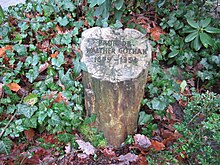Walther Gothan
Walther Ulrich Eduard Friedrich Gothan (born August 28, 1879 in Woldegk , † December 30, 1954 in Berlin ) was a German geologist and paleobotanist . Its botanical author abbreviation is " Gothan ".
Life

Walther Gothan was born the son of a master potter in the small south-east Mecklenburg country town of Woldegk and was baptized with the name Walther Ulrich Eduard Friedrich, of which he himself only used the first name (Walther). So far nothing has been known about his education. During his studies Gothan was an assistant at the Prussian Geological State Institute . He received his doctorate in 1905 on "the anatomy of living and fossil gymnosperm woods". Through his teacher, Prof. Henry Potonié , the nestor of German paleobotany, Gothan came to his later field. In 1912 he took over the representation of Potonié at the Bergakademie Berlin , which later became part of the mining department of the Technical University of Charlottenburg (later TU Berlin ). There he received the status of a non-civil servant, associate professor in 1919, a full professorship from 1926 and on January 24, 1927 he became honorary professor at the University of Berlin.
The investigation methods of coal petrography were developed and expanded under Gothan. The pollen and spore analysis was also introduced in coal research. He paid particular attention to researching the coal of the Ruhr area , but also the flora of Spitzbergen, where he was also honored with a geographical name, the Gothan ridge.
Walther Gothan wrote over 300 scientific papers on palaeobotany, in particular on the coal and lignite flora, and on coal petrology. Gothan was an extremely musical person, who mastered several orchestral instruments and also had a poetic and humorous streak. Among others, his poem “What is a geologist?” Is one of the most cited in student and professional circles. After the Second World War he worked for the Academy of Sciences of the GDR , of which he became a full member in 1949, and the Humboldt University in Berlin. However, he kept his residence in the western part of the city in Charlottenburg , where he also died. Gothan was one of the last paleontologists to have a complete picture of the field of paleobotany.
In 1948 he received the Leopold von Buch badge . In 1954 he became an honorary member of the Paleontological Society .
Walter Gothan died in Berlin at the end of 1954 at the age of 75. His grave is in the Heerstraße cemetery in Berlin-Westend (grave location: II-W10-134h).
Fonts
- About the genus Thinnfeldia Ettingshausen. In: Abhandlungen der Naturhistorische Gesellschaft zu Nürnberg, Volume XIX (1912), Issue 3, pp. 67–80, plates 13–16.
- The Unterliassische ("Rhaetian") flora around Nuremberg. In: Abhandlungen der Naturhistorischen Gesellschaft zu Nürnberg, Volume XIX (1914), pp. 89–186.
- Potonié ’s textbook on paleobotany. 2nd, revised edition. 538 S. Verlag von Gebrüder Borntraeger , Berlin 1921 ( archive.org ).
- Carboniferous and Permian plants. In: Georg Gürich [Hrsg.]: Leitfossilien. A help book for determining fossils during geological work in the collection and in the field. Third delivery. Publishing house by Gebrüder Borntraeger, Berlin 1923 ( archive.org ).
- [with Hermann Weyland ]: Textbook of paleobotany. 1st edition. Akademie-Verlag , Berlin 1954. (has been translated into both English and Russian)
literature
- Ilse Jahn: Gothan, Walther Ulrich Eduard Friedrich. In: New German Biography (NDB). Volume 6, Duncker & Humblot, Berlin 1964, ISBN 3-428-00187-7 , p. 654 ( digitized version ).
Individual evidence
- ↑ His name is not found in the high school graduate registers of higher educational establishments in Mecklenburg.
- ^ Members of the previous academies. Walther Gothan. Berlin-Brandenburg Academy of Sciences , accessed March 30, 2015 .
- ^ Hans-Jürgen Mende : Lexicon of Berlin burial places . Pharus-Plan, Berlin 2018, ISBN 978-3-86514-206-1 . P. 487.
Web links
- Literature by and about Walther Gothan in the catalog of the German National Library
- Literature about Walther Gothan in the state bibliography MV
| personal data | |
|---|---|
| SURNAME | Gothan, Walther |
| ALTERNATIVE NAMES | Gothan, Walther Ulrich Eduard Friedrich (full name) |
| BRIEF DESCRIPTION | German geologist and paleobotanist |
| DATE OF BIRTH | August 28, 1879 |
| PLACE OF BIRTH | Woldegk |
| DATE OF DEATH | December 30, 1954 |
| Place of death | Berlin |